~ 2 ~
~ The Study of Threes ~
http://threesology.org
Researchers as of 8/29/2019
| Devil's Advocate Series: | ||||||||
|---|---|---|---|---|---|---|---|---|
| 1 | 2 | 3 | 4 | 5 | 6 | 7 | 8 | 9 |
| 10 | 11 | 12 | 13 | 14A 14B |
15 | 16 | 17 | 18 |
| 19 | 20 | 21 | 22A 22B |
23 | 24 | 25 | 26 | 27 |
| 28 | 29 | 30 A | 30 B | 31 | 32 | 33a | 33b | 33c |
| 34 | 35 | 36 | 37 | 38 | 39 | 40 | 41 A | 41 B |
In the present course of research I am utilizing the role of a Devil's Advocate because of three recurring conditions (which will be somewhat elaborated on):
- Condition #1: I have come across an abundance of examples that can be interpreted to be constructed in an "other-than-three" type of pattern.
- Condition #2: Both (serious) threes research adherents and opponents ("accepters and exceptioners") are few and far between.
- Condition #3: Ideas, hypothesis and theories utilizing some other-than-the-"THREE" number pattern offer indirect objections or exceptions to Threes research.
I have come across an abundance of examples that can be interpreted to be constructed in an "other-than-three" type of pattern, and must be answered (as to why they occur)... in terms of identifying their (instead of a "three") placement alongside the abundance of 'threes' which have been uncovered. Are they part of an alternative sequence-of-three such as:
- 0-1-2
- 1-2-3
- 3-to-1
- 2-3-4
- 5-6-7
- number-word-pause
- zero-zero-word
- sound-silence-sound
- etc....
...All of which may or may not comprise some variation of an easily recognized (culturally or subject referenced common) "three"; such as the recurring sets-of-three in a mathematics derived sequential enumeration: (ones-tens-hundreds)/ (thousands-ten thousands- hundred thousands)/etc... Then again, are they a pattern-of-three whose sequence does not follow a conventional formula of enumeration, with or without numbers or symbols and primarily occur as inferences, feelings, hints, "shadows", intimations, sounds, etc.? (For example, many three-patterned expressions don't give the impression of any numerical order, but are linguistically practiced as a pattern-of-three in a given culture... such as for example the "24- 7- 365" (referring to 24 hours a day, seven days a week, 365 days a year)... and exhibit a "hidden" pattern-of-three in that the numbers 1-8-9 are excluded. Another example would be in the case where a person, by their own conventionality, will sneeze or yawn or cough or brush their hair, or adjust their glasses, or fiddle with a pen or pencil, etc..., in an unconscious pattern-of-three movement, whether successively or intermittently over a few moments.
In other words, it is the absence of an otherwise abundant pattern (numerical or otherwise) in one or another circumstance which should pique one's curiosity and not be over-valued, under-valued, nor disparaged or interpreted egotistically (as some projected self-referencing of personalized significance). Whereas we come to recognize a pattern that others overlook or take for granted, yet we too overlook and take for granted the absence of the one or more patterns which have garnered our attention and become a pastime of extended interest. The absence of a repetition is also a pattern... like the presence and absence of a sequence in a code (for example the pauses between the dots and dashes of Morse code, the transitional periods between the 3 stops and 1 start in amino acids, the intervals of gradation in music, speech, and writing, the seasonal intervals of climate change, the intervals of birth, war, relative peace, anger, laughter, health, illness, injury, economics, revolution, cultural ceremonies, etc...)
While some "three"-based models are widely recognized, others may be the result of cultural, personal, or group-related preference. This is not to say that such observations are incorrect, but to make it known that preferences for one or another pattern can be identified... and that some observations do in fact yield the presence of multiple patterns. Further relationships or correlations may or may not take place within, alongside, or external to a respective research orientation. Eventually, however, a choice should be made in an effort to acquire additional information and knowledge as to the applicable fruitfulness of one or more patterns over another or others. We should not let variance set us back nor dissolve our resolve to include variances of patterns in the overall research in order to determine the wider extent of occurrence so that change over time... if any, can be identified. However, if your research is limited to a stringent set of criteria (solely within a given subject reference), a larger perspective of human cognition may not come to mind, nor will one be able to inter-relate their research with other subjects for a larger comprehension of inter-related overlapping... which is of particular importance in biology because it is an accumulation of various accumulations and over-lappings over long expanses of time. let us take an example of variance and the result of what might otherwise be interpreted an anomaly without statistical relevance if only a few examples are identified. Fortunately, the following authors do not dismiss the findings of a "variable threes occurrence", even if they are not aware of how wide-spread the occurrence of the threes phenomena actually takes place. The example comes from an examination of the number of turns to the human Cochlea:
Biedron S1, Westhofen M, Ilgner J. Abstract OBJECTIVE: The number of human cochlear turns is generally accepted being 2 1/2, although cases with up to 2 3/4 or even 3 turns are known from literature. This study was performed to evaluate the actual number of cochlear turns and its variance. METHODS:Histologic temporal bone series from the "Wittmaack temporal bone collection" (Hamburg, Germany) were examined, and the number of scala media segments was counted using the mid-modiolar sections. These data were evaluated in reference to the cochlear spiral to obtain the number of cochlear turns. RESULTS:Sixty-five percent of the investigated specimens had more than 2 1/2 cochlear turns, of which, 11% had more than 2 3/4 turns. CONCLUSION:The number of human cochlear turns shows a higher variance than is represented in literature. Cases with up to 3 turns can be regarded as upper limit of the normal range. This finding may carry further implications for cochlear implantation to focus on the development of individually shaped electrode carriers and stimulation strategies. |
As an aside comment, some readers may have overlooked the three quantities given: (2 1/2, 2 3/4, 3). But the point to make is that there is a "three" relevance, particularly when we take into consideration other items related to the ear, which alters the overall placement of the value "3" in the analysis of the ear... and by extension, human speech... and therefore the dimensions of inter-relatedness between language and cognition. Which begs the question, does the recurring presence of such a pattern influence interpretations of what we think we see? Let us imagine what speech and human cognition might be like if the ear exhibited some other pattern(s). Like the stages (or gradations) of evolutionary development along a course of: Protoplasmic differentiation of internal structures, cell-to-cell aggregations, cell-to-tissue layerings, tissue-to-organ inter-lacing, and organ-to-organ integrations, which have accumulated like the three basic rock formation processes: Igneous- Metamorphic- Sedimentary.
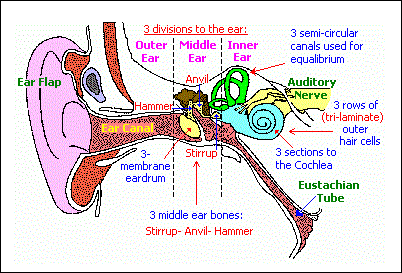
Language threes, page 1
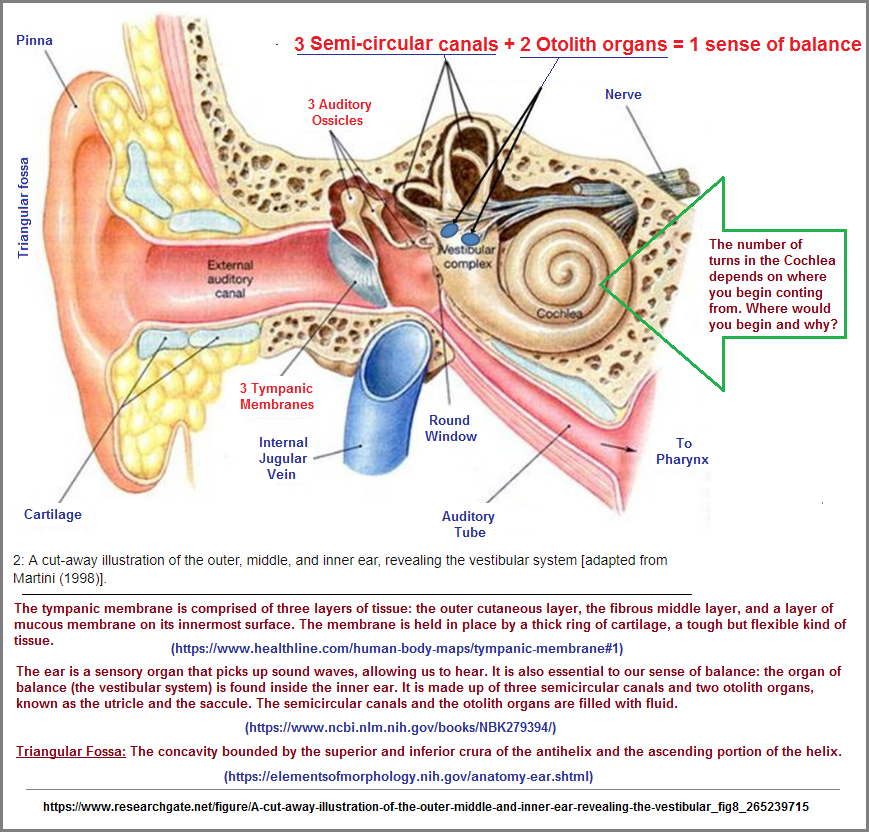
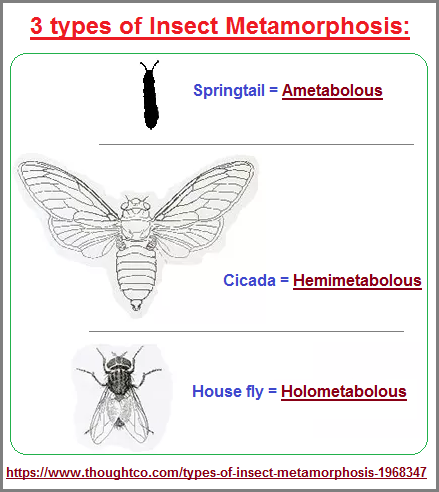
Yes, I recognize several different types of "three" patterns, and have done so long enough as to begin recording an absence of what appears to be a regularity... In other words, patterns-of-three are not a regularity in all instances for all things. If the three is as important as one might initially claim by being overwhelmed as to the quantity and variety of occurrences, then why is there a recordable frequency of absence? Such a question presents us with the need to chart out a timeline of threes occurrences to note whether there is or is not an equilibrium, a decrease, an increase, or decipherable fluctuations... just like the appearance of an organism in both the fossil record and extant examples. When speaking of an other-than-three pattern such as when noting the phases, stages or transitions identified in insect development, the different counts (as tabulated by different human perceptions of analysis) need to be catalogued and referenced as part of the time-line data in the era(s) of occurrence. Just because they appear to be everywhere and the established recurrency of pattern(s), does not in anyway suggest they are not a product of a natural creativity outside the norm of the 1-2-3 ensemble, nor are not an anomaly such as we might denote as a mutation. Multiplicity of occurrence... even over long expanses of time, whether or not other patterns are sighted, does not mean the pattern(s) are not a period or rotation rate-specific phenomena acting itself as a transitory occurrence. |
Ideas, hypothesis and theories utilizing some other-than-the-"THREE" number pattern offer indirect objections or exceptions to Threes research. (I say "indirect" because they do not directly assault the research but beg for an answer to their placement, origination, and relationship... if any.)
Very often the direct or indirect objections being made provide a further insight into unraveling a timeline of what might be called an enumeration road map, such as the microbiological origin(s) of life when the numerical patterns of recurring molecular activities are cataloged... though they are done so in the present age of analysis only in a rudimentary fashion because it is difficult for many researchers to apply multiple research topics to a central theme, even while they think they are and may argue otherwise to an assertion that they are merely glossing-over subject matter from different topics of consideration.
While on personal levels they can take multiple everyday considerations and apply them to a singular effort of examination and conclusion... like someone engaging in a mental exercise of multi-tasking, they do not apply this same type of mental behavior to multiple research criteria... only their everyday personal interests. Though the capacity to do so exists, they simply have not practiced it because it is not a socially called for nor expected routine of thinking... only thinking about multiple topics outside of research criteria.
With respect to using the idea of a "timeline" as a model to enhance a "threes" perspective, this entails taking already existing information and subjecting it to an assumed 1, 2, 3... sequencing formula. For example, somewhere along the timeline of life the triplet code appeared, just as did the developmental sequence of the Three Germ layers. When we take into consideration molecules, the elements, atomic nuclei, etc., any enumeration already assigned to them is helpful, but may not necessarily be the most useful. Just because one or millions of researchers focus on a given aspect of a given research entity does not mean their individual or collective interest is particularly suited for a "threes" perspective of integration. While the entity may be used, it is not necessarily to be assigned with the same value or valuelessness already assigned to it and used in the currency to which it is presently being used. Threes research may or may not confirm their present day valuations... some of which no doubt are simply valued by their commercial application in an economic situation.
While looking for examples of timelines, there are different varieties essentially describing the same general themes, as their titles suggest. This is not to say that any single timeline will have all the information you are looking for. Very often one may have to find several different examples and even take the time to mix and match the information to suits one's particular interests at a given time. However, the one you are looking for may not be readily available within the search parameters you use because the timeline is attached to some discussion unrelated to your present interests and the language/vocabulary being used in a given context at a given moment. Indeed, I find that I have had to create a make-shift one on-the-fly in several cases, though there may be one somewhere that fits the information quite nicely and was created by someone with more artistic talent than myself. Nonetheless, I do what I can at the moment.
In many instances, it should be noted, patterns-of-three exist in unrecognized forms such as in the case where three related ideas or perceptions exist separately and it has not been the cultural or conventionalized human orientation of perceptions to put the three individual examples together. For example, while many people know of the Rosetta Stone and its three languages, they may or may not know of two other 3-language inscriptions called the Behistun inscription or the Galle Trilingual Inscription... though other examples may also exist. Why is it so important for "experts" in history and the media to make note of any one of the 3-language inscriptions, but not associate them together, since they are similar ideas and exhibit a particular human behavior over time, whether or not the later occurring inscriptions were performed as an act of imitating the Rosetta stone or not. As an example of a pattern-of-three occurring in different places at different times, we must assume that this type of human behavior occurs in other instances, across cultures and across subject matter. Indeed, as an affront to those who claim the importance of some other number pattern, why aren't there representative examples of stone inscriptions with two, four, five, six, seven, eight, nine, etc... languages? Why does the pattern-of-three occur so frequently, and yet not all the time in every single instance? How many patterns-of-three (and other patterns) are we overlooking? Why aren't so-called experts in different fields of research and compilation integrating the close and distant examples... and then because they don't, we as a society are disposed to think less of such an exercise... of such a study that doesn't occur in some University setting?
It is particularly irritating to have to search for a variety of timeline presentations instead of finding them all in one place in order to compare various types of related information. Many of us need lots of information to make a ready evaluation because we are capable of scanning lots of information at a single moment in order to establish an encapsulated holographic image... (or perhaps I should say whollo-graphic since I am combining the three ideas of whole, holistic, hollo-gram). With this in mind, I culled three examples from different Wikipedia pages and placed them onto one image (which is a 3-into-1 profile). Since the image is rather large, it may take a few moments to load for some viewers. And no, I am not claiming the information is correct, since so many timelines are based on time period generalities, I am merely presenting it as an example of information that can be put together side-by-side for those like myself who prefer to have a large array of seeming divergent but inter-related information in one setting to perceive as a mix of correlatable data... and yet even this example fails to portray the divergency of materials needed to be surveyed in a threes research perspective of analysis. All too often authors of information have spent so much time on a singular project they use it as a definition of some extensive value, instead of realizing it is but a small fragment of a larger picture which needs to be viewed. In other words, their efforts are personally over-valued and selectively isolated as if in an act of separation, and act of isolation, an act of "oneness" positioning, this provides the person's or group's effort with some token of greatness to be applauded and ceremonially praised; whereas being placed side-by-side other efforts, this somehow cheapens or belittles their time and energy as an individualized or collective enterprise of originality, creativity or even genius. As it is, a basic criteria of psychology is to place a value on something by the effort and energy (if not hardship and overall costs) it has had on someone, though someone else having engaged in the same thing would have been less arduous.
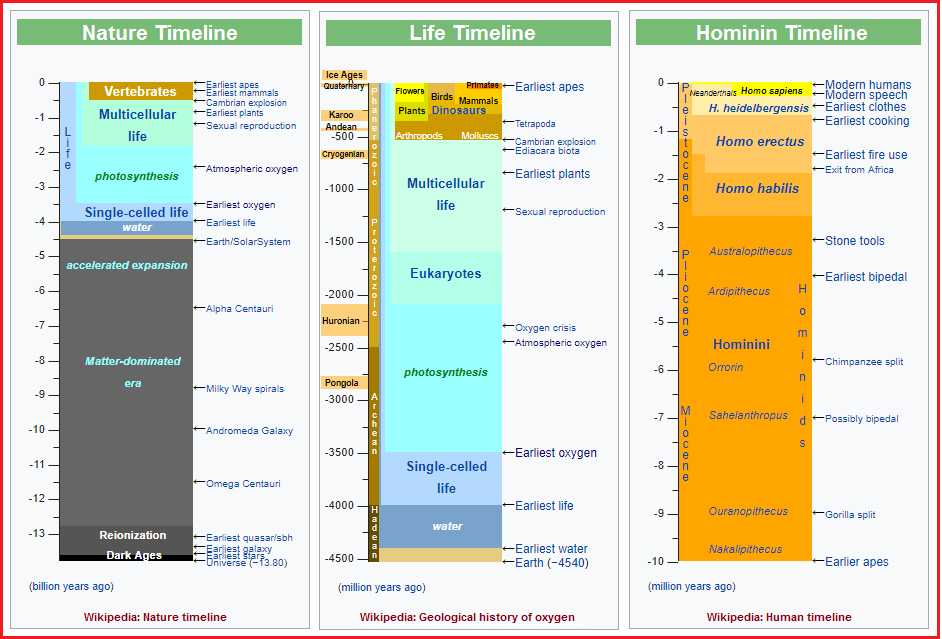
Sources:
Both (serious) threes research adherents and opponents ("accepters and exceptioners") are few and far between.
Present advocates are those generally practicing the form of pursuing a singular idea involving some selective utilization of a "three" reference— and objectors are those who profess the over-riding value of some other-than-three (or any number) pattern (such as those professing the value of the number seven); both of which are usually encountered either through wayward contacts or direct conversations that I initiated. Typically however, those who raise an objection by citing some other pattern, are simply exercising some knee-jerk reaction that can be easily answered. The most difficult questions come by way of my own insistence of unraveling what can be described as a mystery, even if others dismiss the currency of number associated patterns as being irrelevant to their day-to-day survival interests which are very often linked to those interests which they believe have some social value... superficial or serious.
It should be noted for those readers who have not interpreted it from other pages, that the numbers 1 and 2 and 3 are not the sole pattern by which I catalogue enumerated patterns. Any and all three-patterned number arrangements are to be catalogued, as well as an absence thereof, because a pattern-of-two may reveal not the absence of a pattern-of-three, but the practice of someone's perception or preference for an other-than-three representation. For example, whereas it was once customary to associate a "1" to designate a single molecule such as H2O1, it had been decided that the mere presence of a recognized molecule was enough to claim that there was a single molecule present. A person who is obsessively focused on number arrangements may be inclined to overlook the presence of a "1" because its symbol is not there.
Yet, it is not the mere encyclopedic model of cataloguing that I pursue, though such an effort is highly welcomed. The information in my ongoing cataloguing efforts are being directed as a type of alternative illumination to already existing information. For example, as part of the organizational methodology taking place, in my mind I am constructing a timeline of occurrences, similar to that having occurred in the commonly viewed two-patterned geology + biology scenarios which may independently portray a selective (or selectively grouped) biological index of geological events occurring with sea animals, plants, trees, land animals, birds, Dinosaurs, hominids, etc... In other words, the underlying patterns of enumeration to be identified with the already collected materials of others provides for a different perspective. For example, a typical time line is as follows:
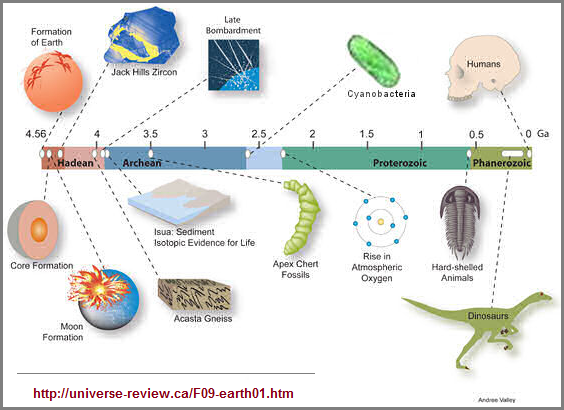
An alternative view, as will be mentioned again later on, is the addition of a third variable to the commonly occurring geology + biology timeline compilation, which is the application of generalized rotation rates of the Earth for the mentioned periods of time. For example:
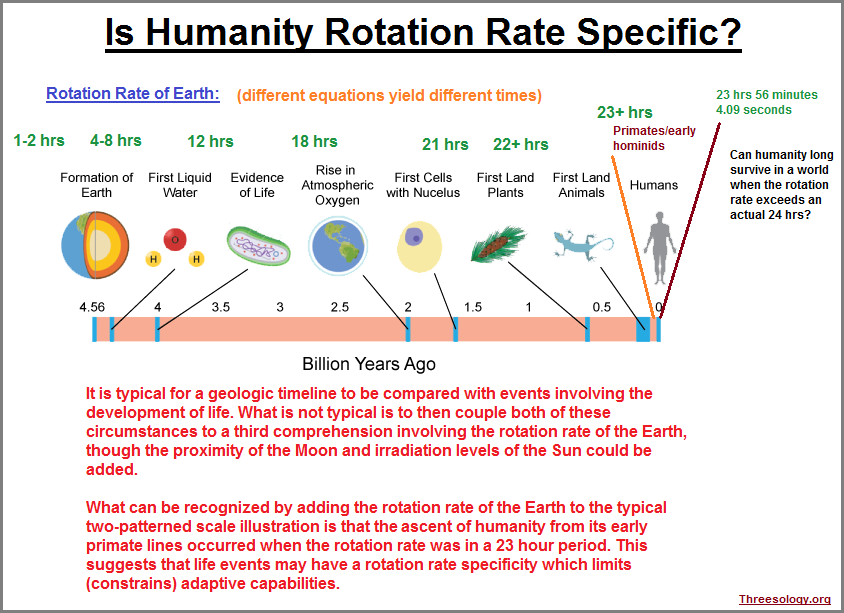
In the timeline I am proposing, is that we take all the current data and subject them to a "Threesological" interpretation (which involves all number patterns viewed from the perspective of a generalized 1-2-3 maturational development sequence); in that as our numbering system describes, earlier numbers (in this case biologically relevant materials and subsequent biological development), will exhibit a sequential enumeration in accordance with the planetary, geological and overall environmental conditions prevalent for a given period. This also involves the idea that humanity may well be but a small fraction of the natural order of things and that because of the sticky problems found when thinking about the origin of life, we need to consider that RNA and DNA may well have been either directly together as a sort of hermaphroditic (symbiotic) ensemble, or occupied a setting in which they initially interacted, but were later separated.
Here is a thrown-together example of a timeline I am working on, minus all the chemical formulas, even though in reflection the chemical formulas of the "simplistic complexities" found in repeating biological processes are past the initial points of origination:
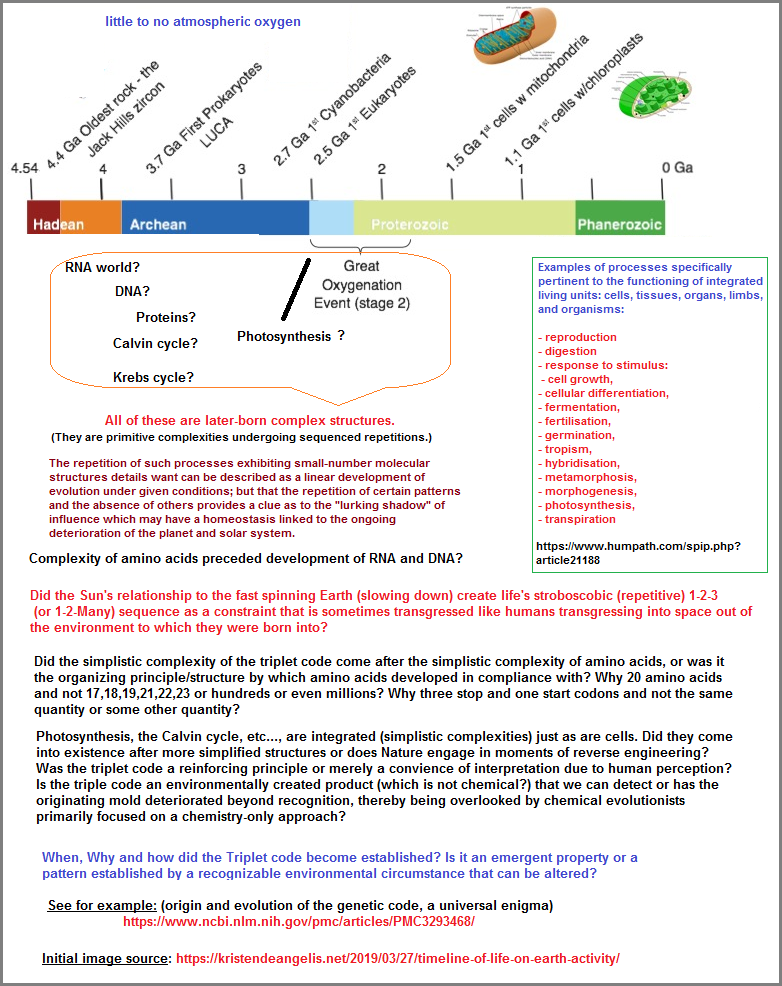
As such, as a representative preliminary towards describing a taxonomic cognitive profile (differing from Maslow's simplistic Hierarchy-of-needs formula) the previously described timeline would lay out the associated numerical patterns of the various items presently being catalogued in generalized schemes, including a reconsideration of the two-patterned Aerobic versus Anaerobic perspective, in which an unacknowledged internalized numeration profile may proceed incrementally to a point beyond a one or two representation, before a "resurgence" (one-two-three revival, recurrence, reflection?...etc...) of a new biological disposition arises defining a "resuscitation" of the one- two- three sequencing. For example, the Anaerobic type of glycolysis most likely came before the Anaerobic (in concert with the change in atmospheric oxygen), thereby describing developmental sequences which may evolve, but that the presumed separated evolutionary events (or viewed in an overlapping way), becomes truncated and overlapped with an Aerobic glycolysis model which begins the 1-2-3 numeration sequence anew. This is not to say that this occurred, but I am merely trying to illustrate a general point that each segment of biological development may express individualized numerical sequences and/or overlapping ones.
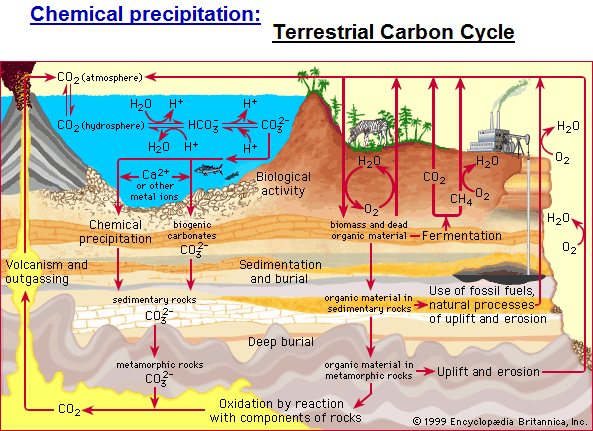 Carbon is transported in various forms through the atmosphere, the hydrosphere, and geologic formations. One of the primary pathways for the exchange of carbon dioxide (CO2) takes place between the atmosphere and the oceans; there a fraction of the CO2 combines with water, forming carbonic acid (H2CO3) that subsequently loses hydrogen ions (H+) to form bicarbonate (HCO3−) and carbonate (CO32−) ions. Mollusk shells or mineral precipitates that form by the reaction of calcium or other metal ions with carbonate may become buried in geologic strata and eventually release CO2 through volcanic out-gassing. Carbon dioxide also exchanges through photosynthesis in plants and through respiration in animals. Dead and decaying organic matter may ferment and release CO2 or methane (CH4) or may be incorporated into sedimentary rock, where it is converted to fossil fuels. Burning of hydrocarbon fuels returns CO2 and water (H2O) to the atmosphere. The biological and anthropogenic pathways are much faster than the geochemical pathways and, consequently, have a greater impact on the composition and temperature of the atmosphere. |
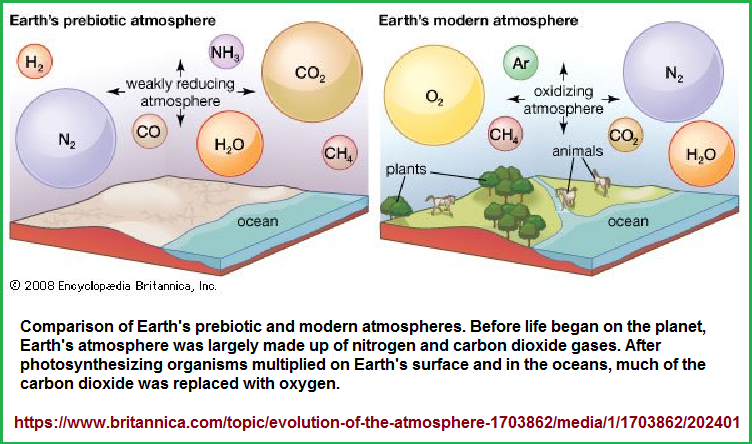 |
Origination date: Tuesday, June 25, 2019... 4:41 AM
Initial Posting: Thursday, August 29, 2019... 4:42 AM
Updated Posting: Tuesday, January 17, 2023... 11:43 AM
Herb O. Buckland
herbobuckland@hotmail.com